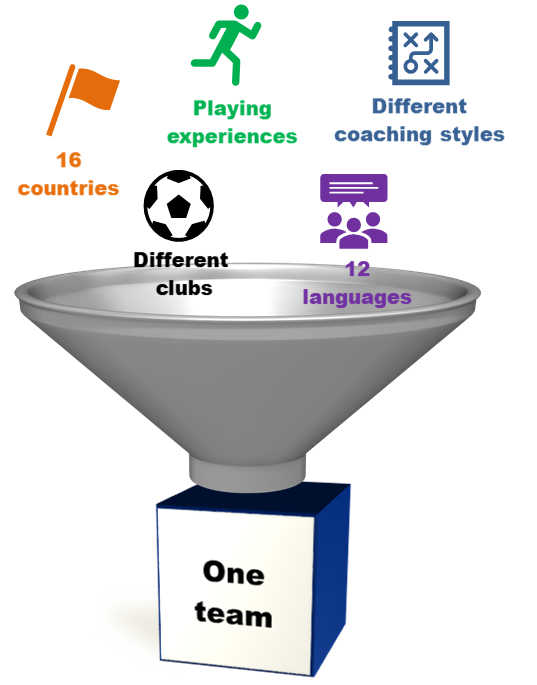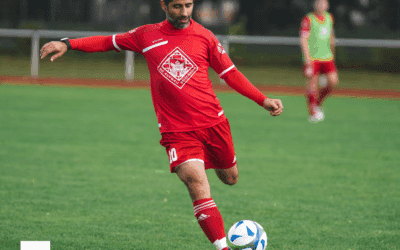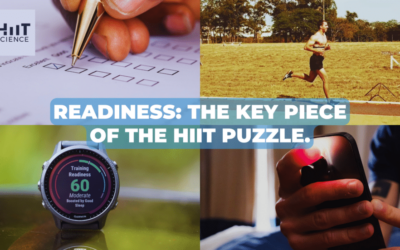‘the ability to resist the temptation of focusing on wins and losses (i.e., outcomes), media reports, and the uninformed opinions of fans on social media, and instead dedicate oneself and one’s team to the hour-by-hour, day-to-day habits that are within your control and which will help incrementally improve your physical and mental ability to perform at your best’.After three seasons of witnessing firsthand the razor-thin margins of error in the high pressure, high stakes world of professional soccer at AS Roma, we believe that developing your process in a club is the best way to approach both individual and team preparation. Given that the length of professional sports seasons is long (11 months in European soccer) it is difficult to perform consistently without a rough patch and/or some form of a dip in team confidence across players, coaches, and staff. However, in our opinion, the best antidote to a crisis of confidence is an unyielding adherence to ‘the process’, one that has been thoughtfully developed, refined, and properly communicated to everyone in the organization. Although doing so will test an organization and given that meticulously following the process will not always guarantee success, as Bill Walsh stated in his book “The Score Takes Care of Itself“, if you religiously follow your process and learn from it, you will dramatically improve your odds of success (Figure 1).

Figure 1. Components of an efficient process
Developing a Mission Statement
In addition to the process, you can improve the success of your club by defining your organizational objectives through the development of a mission statement and adopting core values that guide your organization’s decision making and behavior. To some, this may seem like a corny and outdated exercise. But based on personal experience, reading, and research, we believe a well-written mission statement will pay dividends for organizations that choose to create them and, more importantly, live by them. As a performance group at AS Roma, we identified the core values that guided our work and used those values to inform the development of a team-wide mission statement. This statement helped to guide our decisions as they related to training, recovery, rehabilitation, treatment, and return-to-play. We displayed this mission statement in a prominent place in our staff office, where players and technical coaches could see it, and where it served as a constant reminder of our commitment to the players, team, and to our own professional standards.Culture & Diversity
It’s next to impossible to write about our experience at AS Roma without highlighting the cultural diversity at the club (Figure 2). This diversity is the almost universal reality in professional soccer, the most global sport on the planet.
Figure 2. Summary of the diversity at AS Roma
This culture should not be reliant on individuals, but rather on an ethos that is passed from season to season and from team to team.How one creates a resilient team culture has been debated and written about widely, and this body of literature highlights that there is no single recipe for success. Whilst we think there are many ways to create a strong club culture and identity, there are some common denominators that can help. We believe the critical ones are simply hard work and consistent follow-up. Once your team culture and identity are developed and well established, you can use it to develop your academy talent and filter the players you sign as transfers from other clubs. Of course, this all requires strong leadership, strategic planning and a conviction in your mission that is clearly transmitted to everyone in the organization. But we believe this approach serves as the cornerstone of sustained success for those who choose to use it. Sporting Islands Another interesting, observable feature of the European soccer culture is the desire to exist on a sporting island. Some clubs aim to live in a closed society, keeping their processes secret. However, the idea that professionals in one club or sport can’t learn from the methods of professionals in another club or sport, strikes us as incredibly closed-minded and produces a self-limiting mentality. In our experience, it is helpful to look at things with fresh, unbiased eyes. Doing so has resulted in some of the best breakthroughs in our careers, and in the careers of the colleagues, we most admire. Closing oneself off to ideas that may not exist in the common discourse of your own club ignores the provocative question that Lee Cockerell (Walt Disney World Executive) poses in his book ‘Creating Magic’:
“What if the way we have always done things is wrong?”This question demonstrates how an open, growth mindset is needed to avoid mistakes when possible and to learn from mistakes when they are made. Questioning and challenging the way in which things are done at regular intervals (not only when things have gone wrong) is part of the formula for sustained success and we humbly admit that it should be part of any clubs ‘process’. Looking at other major sports in the world, we witness the free exchange of ideas and methods between evidence-based practitioners across the sports world. Why some people in European soccer would shut themselves off from this continues to be a mystery to us. Like the Italian sports science researcher, Marco Cardinale has wisely said with regards to performance enhancement:
“your sport isn’t different, you just think it is”.The Need for Thinking Fast and Slow In his book Thinking Fast and Slow, Daniel Kahneman explains that we all have 2 systems of thought. System 1 is the automatic system and is conditioned by past experience and emotion, while System 2 is the more evolved and logical thought mechanism used for advanced problem-solving. Both systems are extremely important for a fruitful human experience but most of us are guilty of over-relying on System 1. However, doing so increases the odds of confirmation bias when attempting to think through a complex situation, resulting in less than optimal response. The reason for referencing this is that the pace of work and day-to-day developments inside a professional sports organization can leave little time for the type of longer-term, logical thinking best done when stepping back from an intensely competitive situation.
Just keeping your process operating smoothly and dealing with the unforeseen issues that arise in a sporting environment often requires the staff’s full energy and undivided attention.Whilst at Roma we came to believe that organizations of all kinds should employ a thinking fast and slow model, whereby a portion of the organization’s human resources are allocated toward longer-term planning and strategizing about every element that contributes to success or failure. In order for this concept to be successful, the “slow” thinkers need to be insulated from the “fast thinking” environment, so as not to be contaminated by the pace, energy, and drama of the day-to-day. For many teams, this type of arrangement might best be accomplished through the use of consultants who only interface with the “fast thinkers” at regular, managed intervals. In the world of professional soccer, international breaks offer good opportunities for these types of collaborative meetings. Perspective and Complex Systems Thinking Fergus Connolly, PhD highlighted a scenario that gets played out countless times a day, within every team, at every level. He highlights that:
For instance, technical coaches see fantastic individual play and favorable win/loss records through the prism of tactical prowess. Game coaches assume that they put the players in the correct positions at the right times, make the correct substitutions, devise and execute a flawless game plan to produce an important win. However, players see the preparation done by all the coaches as somewhat irrelevant and instead believe that the win came from their own determination and skills, most of which they already possessed regardless of the preparation leading up to the competition. In this scenario, everyone takes triumphant credit for a pleasing outcome. Yet, when the same team is confronted with a loss, the same group of people start recognizing the parts played by everyone else in the team environment, but not in a favorable way. From the coaches perspective, the performance team did not do an adequate job keeping players injury-free, that the players were weaker, slower, and less fit than their opponents. Alternatively, the performance department may question the starting line-up because the previous week’s physical data revealed that other players were better prepared to play, or that the substitutions came too late and in the wrong positions, etc. Of course, the point of this somewhat cynical example is that the human experience is often self-centred. Thus, seeing a series of events from an alternative perspective requires effort fueled by a particular mindset.those involved in the operation of the team, view individual performances and team results through their own prism.
Whilst at AS Roma we realized that this more considerate mindset, combined with the application of complex systems thinking, would yield the best chances for long-term success in any organization, sports or otherwise.Complex systems thinking teaches us that the whole is greater than the sum of its parts and that individual parts no matter how good on their own, cannot be fully leveraged within the context of the larger system unless proper attention has been given to how individual parts interact with one another. Several books have been written on this topic, most notably The Fifth Discipline by Peter Senge. For a brief explanation of the concept, we recommend watching Dr. Russell Ackoff’s TED talk. Complex systems thinking should be adopted as a means to achieve sustained excellence in an organization or team. Efforts to improve are often pursued without considering the whole system. If an improvement is made in one area but those improvements are not fully implemented and/or leveraged for quantifiable results then much of the resources used for those improvements are wasted. We think that is a consideration organizations must start with when designing improvement programs, and this thinking dovetails with our previous encouragement to think fast and slow. Truly strategic improvements designed to benefit the entire system are difficult to conceive in the midst of the fast thinking environment. Yet, the appropriate knowledge of the fast thinking environment is required to create a sound improvement plan. In other words, the plan should integrate the expertise and experiences of the day-to-day practitioners but it should ultimately be a product of slow, strategic thinking. John Wooden summed this up when he said:
“planning places effort where effort is needed most.”Ego is the Enemy Ryan Holliday’s book, Ego is the Enemy, has provided an enlightening framework with which to observe the workings of organizations and the human interactions that comprise them. Holliday makes a compelling argument that ego is often the only thing preventing individual and collective improvement. We have also come to believe that the most significant obstacle to implementing thoughtful systems designed for maximum organizational success is the egos of the people who stand to benefit from potential success. For example, within many organizations, those who get the credit for success has become more important than the success itself. And the rush to anoint a single savior or protagonist for wins, losses, great plays, etc., by fans, and social media-saturated culture, undermines the inescapable reality that success of any kind, is almost always due to the contributions made by a group of people. Higher profile players or members of a management team will often be asked to speak for an organization, but this should be viewed as an opportunity to acknowledge that success and failure are owned by everyone in the organization. If leaders can successfully put their own egos aside and create a circle of safety, as Simon Sinek refers to in “Leaders Eat Last,” then the natural outgrowth is a sense of security that fosters organizational buy-in, appropriate risk-taking, and a teamwork ethos that keeps everyone united and on task. Conclusion
“You can be knowledgeable with other men’s knowledge, but you cannot be wise with other men’s wisdom.” -MontaigneWe love this quote from Montaigne. We included it not because we presume to have accumulated a vast amount of wisdom, but because our experience at AS Roma has reaffirmed to us that the path to wisdom will always wind through the forest of living, doing, observing, and engaging. The things we have learnt by doing things outside of our comfort zones and by challenging our deeply held biases have been transformational. Our hope is that we can continue to extrapolate what we have learned from our three seasons at AS Roma and apply them to whatever challenges come next with humility and earnestness. Find Ed and Darcy on Twitter and for more information about Darcy and the services he offers head to darcynormanconsulting.com






